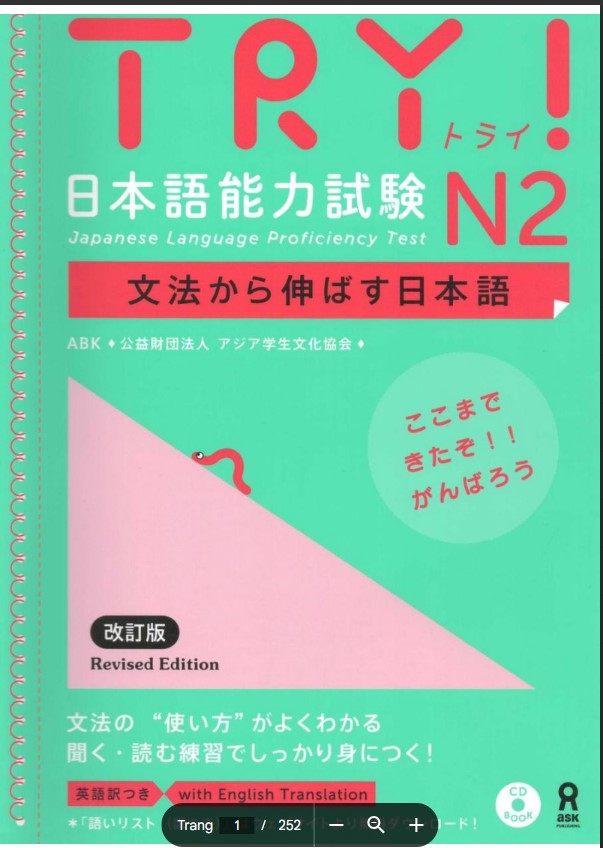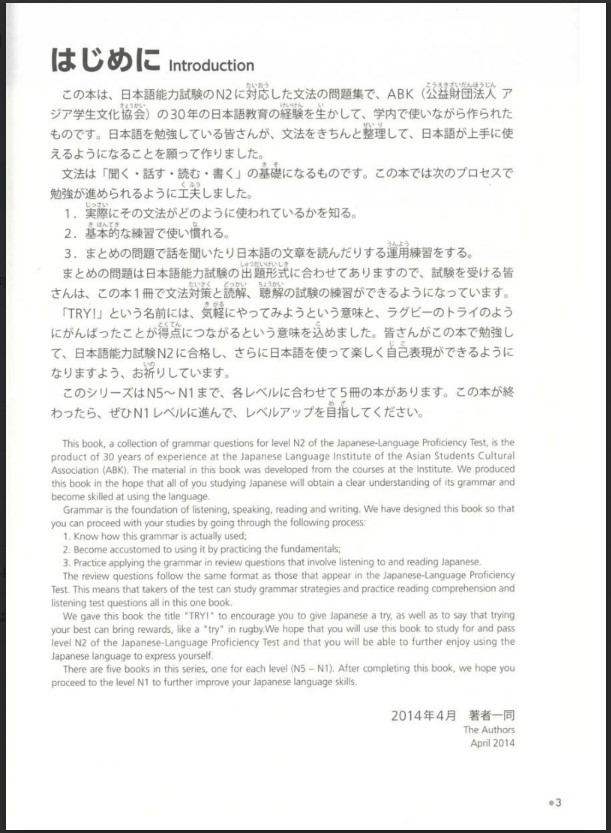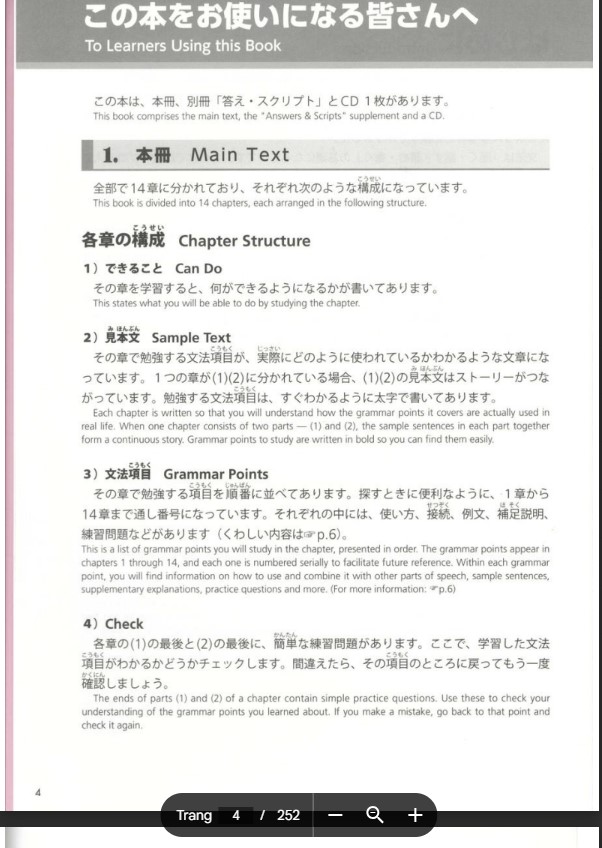


Hình 1:
はじめに Introduction
この本は、日本語能力試験のN2に 対応した文法問題集で、ABK (公益財団法人 アジア学生文化協会) が 30 年の日本 の語学教育の経験を生かして、学内で使われる教材を基に作られたものです。日本語を熟練している皆さん が、文法をきちんと整理して、日本語が上手に使えるようになることを願って作りました。
文法は「聞く・話す・読む・書く」の基礎になるものです。この本では次のプロセスで 勉強が進められるように工夫しました。
- 実際にその文法がどのように使われているかを知る。
- 基本的な練習で慣れる。
まとめの問題を解いて聞いたり日本語の文章を読んだりする練習をします。
この問題集は日本語能力試験の出題形式に沿って作られておりますので、試験を受ける皆さんは、この本で例文と読解、聴解、難解の練習ができるようになっています。「TRY」という名前は、気軽にとってみようという意味と、ラピートのトイのようなに がんばったことが 得点につながるという意味を込めました。皆さんこの本で勉強し、日本語能力試験N2に合格し、さらに日本語を使って楽しく自己表現ができるように なりますよう、お祈りしています。
このシリーズは N5~N1 まで、各レベルに合って 5 冊の本があります。この本が終わっ たら、ぜひ N1 レベルに進んで、レベルアップを目指して下さい。
This book is a collection of grammar questions for level N2 of the Japanese-Language Proficiency Test, the product of 30 years of experience at the Japanese-Language Institute of the Asian Students Cultural Association (ABK). The material in this book was developed from the courses at the Institute. We produced this book in the hope that all of you studying Japanese will obtain a clear understanding of its grammar and become skilled at using the language.
Grammar is the foundation of listening, speaking, reading and writing. We have designed this book so that you can proceed with your studies by going through the following process:
- Know how this grammar is actually used.
- Become accustomed to it by practicing the fundamentals.
Practice applying the grammar in review questions that involve listening to and reading Japanese.
The review questions follow the same format as those that appear in the Japanese-Language Proficiency Test. This means that takers of this test can study grammar sentences and practice reading comprehension and listening test questions all in this book.
We gave this book the title “TRY” to encourage you to give Japanese a try, as well as to say that trying your best can bring rewards, like a “try” in rugby. We hope that you will use this book to study for and pass level N2 of the Japanese-Language Proficiency Test and that you will be able to further enjoy using the Japanese language to express yourself.
There are five books in this series, one for each level (N5-N1). After completing this book, we hope you will proceed to the N1 level to further improve your Japanese language skills.
2014年 4月
The Authors
Hình 2:
この本をお使いになる皆さんへ
To Learners Using this Book
この本は、 本冊、別冊、「答え・スクリプト」と CD 1 枚があります。
This book comprises the main text, the “Answers & Scripts” supplement and a CD.
1. 本冊 Main Text
本書は全部で 14 章に分かれており、それぞれ次のような構成になっています。
This book is divided into 14 chapters, each arranged in the following structure.
各章の構成 Chapter Structure
1) できること Chapter Structure
その章を学習すると、何ができるようになるかが書いてあります。
This states what you will be able to do by studying the chapter.
2) 例文 Sample Text
その章の文法で勉強した文法項目が、実際にどのように使われているか がわかるような文章になっています。 1つの章が (1) (2) に分かれている場合、 (1) (2) の文法はストーリーにつながっています。勉強する文法項目は、すぐにわかるように太字で書いてあります。
Each chapter is written so that you will understand how the grammar points it covers are actually used in real life. When one chapter consists of two parts – (1) and (2), the sample sentences in each part together form a continuous story. Grammar points to study are written in bold so you can find them easily.
3) 文法項目 Grammar Points
その章で勉強した語彙項目を順番に並べてあります。探すときに便利なように、 1 章から 14 章まで通し番号になっています。それぞれの, 中には、使い方、接続、例文、補足説明、 練習問題などがあります (くわしい内容は p.6)。
The grammar points studied in each chapter appear in order. To make them easier to find, they are numbered sequentially from chapters 1 through 14. Within each chapter, you will find information on how to use and combine it with other parts of speech, sample sentences, supplementary explanations, practice questions and more. (For more information: → p.6)
4) Check
各章の(1)の最後と (2) の最後に、簡単な練習問題があります。ここで、学習した文法項目がどうかチェックします。間違えたら、その項目のところに 戻って もう一度 確認しましょう。
The ends of parts (1) and (2) of a chapter contain simple practice questions. Use these to check your understanding of the grammar points you learned. If you make a mistake, go back to the point and check it again.
5) まとめ の問題 Review Questions
その章で勉強した文法を中心にした、文法、読解、聴解、難解の問題です。日本語能力試験 の出題形式に合わせた形になっていること、文法項目の再確認をしながら、試験対策 ができます。
These questions test you on grammar, reading comprehension and listening related to the grammar you studied in the chapter. They follow the same format as the questions that appear in the Japanese-Language Proficiency Test, so you can prep for the test as you review the grammar points.
2. 別冊 Supplement
- 「やってみよう!」 「Check」 の答え
Answers for the “Try it Out!” and “Check” sections - 「まとめの問題」の答え・スクリプト
Answers and scripts for “Review Questions”
3. CD
「見本文」と、「まとめの問題」の聴解問題の音声
Listening exercise audio for “Sample Sentences” and “Review Questions”.
4. 公式サイト Official Site
http://www.ask-books.com/jlpt-try/
本書で使われている言葉の「語彙リスト」があります。語彙リストには、英語の訳がついています。ダウンロードして使っ てください。
You can find the “Vocabulary List” for the words used in the main text. The Vocabulary List has English translations. Feel free to download it.
Hình 3:
《文法項目の中にあるもの》 Inside the Grammar Points
★★★
文法項目の右端に、★ のマークがあります。★が多いほど、重要な項目という意味です。★は理解できればよい項目なので、基本的な練習問題はありません。まとめの問題に が入っていないものがあります。
You will see stars (*) to the right of a grammar point. The more stars you see, the more important that point is. Simply understanding a starred grammar point is enough; they generally do not come up in practice questions. Some do not appear in Review Questions, either.
使う場面 Mark When-to-Use Marks
[友達や家族など、身近な人とおしゃべりをするときに使われる表現です。]
This expression is used when talking to friends, family members or other familiar people.
[友達や家族とおしゃべりをするときには使われない、硬い表現です。]
This expression is formal and not used when talking to friends or family members.
[目上の人や初対面の人に対して話すとき、または店員が客に向かって話すときの表現です。]
This expression is used when talking to a higher ranking person or a person one has met for the first time, as well as by a store clerk when talking to a customer.
[後輩や元気、相手を批判したりするときに使われる表現です。]
This expresses regret or disappointment, and is used when criticizing another person.
[対象を高く評価したり、いつつもの評価が高いことを認めたりするときに使われる表現です。]
This expression is used when you highly praise the topic of the conversation or when you acknowledge that something is generally held in high regard.
どう使う?
1. 使い方 Usage Explanation
どんなことを言いたいときに使うか、どんな気持ちで使うかが書かれています。英語 の翻訳もついています。
This will tell you when you can use the grammar point depending on what you want to say, as well as what nuance it carries. There is also an accompanying English translation.
2. 接続の説明 Explanation on Combining with Other Parts of Speech
どんな品詞のどんな形のものと一緒に使われるか、記号を使って示しました。
例: N + で
This section uses symbols to show you how you can use other parts of speech with the grammar point and in what form. Example: N + で
We have also taken into consideration the frequency with which combinations are used and have not printed those forms that are not used much.
3. 例文 Sample Sentences
①②のように番号がついています。例文は日常生活でよく使われるもので、また、 のマークは、慣用的に使 われる助けになるように一つイラストをつけました。また、 のマークは、慣用的に使 われる表現 を表します。
Sentences are numbered ①, ②, and so on. We have selected sentences for the samples that are often used in everyday life. Some are accompanied by illustrations to help you understand the mark means the sentence contains an idiomatic expression.
やってみよう!
その文法用語を確認する練習問題です。 「どうう」 や例文で勉強したことが どうかどうか、実際に答える形でチェックしてみてください。
This section contains practice questions to reinforce the grammar points you learned in the “How to Use” section and the Sample Sentences by answering these questions.
[ ]
ほかの言葉との使い方 の違い や、追加で説明が必要なことなどが書いてあります。練習 が必要なものは 「やってみよう!」 がついています。
This section contains similar differences in the use of other words/expressions or matters requiring further explanation. Points that require further practice also come with a “Try it Out!” section.
Plus
違う言葉で、同じような意味で使われるものが書かれてあります。練習 が必要なものは 「やってみよう!」 がついています。
This section contains ways to express similar meanings but with different words. Points that require further practice also come with a “Try it Out!” section.
[ ]
その記号と似た項目があるときは、参照ページを書いてあります。
This symbol will direct you to pages with similar grammar points.
Hình 4:
(This image is a continuation of the content related to grammar points, explaining how they are used with other parts of speech and providing sample sentences and practice questions. The text here overlaps with Image 3 in describing the “Inside the Grammar Points” section, including the use of stars, usage explanations, combinations, sample sentences, and practice exercises.)
《文法項目の中にあるもの》 Inside the Grammar Points
★
文法項目の右端に、★ のマークがあります。★が多いほど、重要な項目という意味です。★は理解できればよい項目なので、基本的な練習問題はありません。まとめの問題に が入っていないものがあります。
You will see stars (*) to the right of a grammar point. The more stars you see, the more important that point is. Simply understanding a starred grammar point is enough; they generally do not come up in practice questions. Some do not appear in Review Questions, either.
使う場面 Mark When-to-Use Marks
[友達や家族など、身近な人とおしゃべりをするときに使われる表現です。]
This expression is used when talking to friends, family members or other familiar people.
[友達や家族とおしゃべりをするときには使われない、硬い表現です。]
This expression is formal and not used when talking to friends or family members.
[目上の人や初対面の人に対して話すとき、または店員が客に向かって話すときの表現です。]
This expression is used when talking to a higher ranking person or a person one has met for the first time, as well as by a store clerk when talking to a customer.
[後輩や元気、相手を批判したりするときに使われる表現です。]
This expresses regret or disappointment, and is used when criticizing another person.
[対象を高く評価したり、いつつもの評価が高いことを認めたりするときに使われる表現です。]
This expression is used when you highly praise the topic of the conversation or when you acknowledge that something is generally held in high regard.
どう使う?
1. 使い方 Usage Explanation
どんなことを言いたいときに使うか、どんな気持ちで使うかが書かれています。英語 の翻訳もついています。
This will tell you when you can use the grammar point depending on what you want to say, as well as what nuance it carries. There is also an accompanying English translation.
2. 接続の説明 Explanation on Combining with Other Parts of Speech
どんな品詞のどんな形のものと一緒を使われるか、記号を使って示しました。
例: N + で
This section uses symbols to show you how you can use other parts of speech with the grammar point and in what form. Example: N + で
We have also taken into consideration the frequency with which combinations are used and have not printed those forms that are not used much.
3. 例文 Sample Sentences
①②のように番号がついています。例文は日常生活でよく使われるもので、また、 のマークは、慣用的に使 われる助けになるように一つイラストをつけました。また、 のマークは、慣用的に使 われる表現 を表します。
Sentences are numbered ①, ②, and so on. We have selected sentences for the samples that are often used in everyday life. Some are accompanied by illustrations to help you understand the mark means the sentence contains an idiomatic expression.
やってみよう!
その文法用語を確認する練習問題です。 「どうう」 や例文で勉強したことが どうかどうか、実際に答える形でチェックしてみてください。
This section contains practice questions to reinforce the grammar points you learned in the “How to Use” section and the Sample Sentences by answering these questions.
Plus
違う言葉で、同じような意味で使われるものが書かれてあります。練習 が必要なものは 「やってみよう!」 がついています。
This section contains ways to express similar meanings but with different words. Points that require further practice also come with a “Try it Out!” section.
[ ]
その記号と似た項目があるときは、参照ページを書いてあります。
This symbol will direct you to pages with similar grammar points.
Hình 5:
コラム 目次
COLUMNS Table of Contents
これも覚えよう!
せつぞく Affix / 词缀 / Phụ tố
1 接続 Degree / 程度 / Mức độ
① 高~15 ②低~22 ③好~悪······27 ④名~32
5~7 金銭 Money / 金钱 / Tiền bạc
① 貴~41 ②金~41 ③料~41 ④貨~56
8~10 用途 Usage / 用途 / Ứng dụng
① time / 時間 / Thời gian ……………… 71 ②~向き 75 ③~向け 76
11~13 とき Time / 时间 / Thời gian
① 今 ~ 現 ・・・ 81 ②~現 ・・・ 85 ③~再 ・・・ 89
14~16 感情等 Emotions, etc. / 情感等 / Tình cảm v.v.
① ~ 感 ・・・ 101 ②~ 観 ・・・ 109 ③~ 心 ・・・ 116
17~18 職業 Work, etc. / 职业等 / Nghề nghiệp v.v.
① ~ 家 ・・・ 135 ②~ 職 ・・・ 140
19~20 程度 High Degree / 高程度 / Mức độ cao
① 大 ~ 149 ②超 ~ 最 ・・・ 158
21~23 印象・感想等 Impression, Opinion, etc. / 印象・感想等 / Ấn tượng – Cảm tưởng v.v.
① ~ やすい 171 ②~ づらい 179 ③~ にくい 185
24~25 状況 Situation / 状况 / Tình trạng
① 反 ~ 逆 ・・・ 194 ②各 ~ 諸 ・・・ 206
26~28 名詞化 Nominalization / 名詞化 / Danh từ hóa
① ~ 性 ・・・ 217 ②~ み ・・・ 222 ③~ さ ・・・ 風 ・・・ 233
29~31 否定 Negation / 否定 / Phủ định
① 無 ・・・ 240 ②不 ・・・ 243 ③非 ~ 末 ・・・ 249
まとめて覚えよう!
いろいろな意味を持つ動詞 Verbs With Many Different Meanings / 有很多意思的动词 / Động từ mang nhiều ý nghĩa khác nhau ………………………………. 271
Link tải Drive: https://drive.google.com/file/d/19U57U29WaOOMKQUnfER48XGrDjzalqwE/view?usp=sharing

